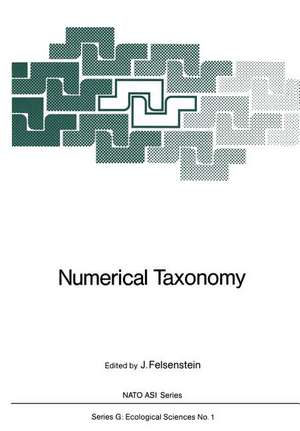Numerical Taxonomy: Nato ASI Subseries G:, cartea 1
Editat de Joseph Felsensteinen Limba Engleză Paperback – 7 dec 2011
Din seria Nato ASI Subseries G:
- 18%
 Preț: 979.22 lei
Preț: 979.22 lei - 18%
 Preț: 956.50 lei
Preț: 956.50 lei - 15%
 Preț: 657.08 lei
Preț: 657.08 lei - 18%
 Preț: 949.10 lei
Preț: 949.10 lei - 18%
 Preț: 1235.25 lei
Preț: 1235.25 lei - 18%
 Preț: 967.40 lei
Preț: 967.40 lei - 15%
 Preț: 663.93 lei
Preț: 663.93 lei - 18%
 Preț: 957.44 lei
Preț: 957.44 lei - 15%
 Preț: 642.51 lei
Preț: 642.51 lei - 18%
 Preț: 950.96 lei
Preț: 950.96 lei - 5%
 Preț: 710.60 lei
Preț: 710.60 lei - 18%
 Preț: 979.08 lei
Preț: 979.08 lei - 5%
 Preț: 1107.06 lei
Preț: 1107.06 lei - 15%
 Preț: 650.69 lei
Preț: 650.69 lei - 18%
 Preț: 966.27 lei
Preț: 966.27 lei - 18%
 Preț: 958.56 lei
Preț: 958.56 lei - 18%
 Preț: 958.56 lei
Preț: 958.56 lei - 18%
 Preț: 962.49 lei
Preț: 962.49 lei - 15%
 Preț: 650.19 lei
Preț: 650.19 lei - 15%
 Preț: 653.33 lei
Preț: 653.33 lei - 18%
 Preț: 960.78 lei
Preț: 960.78 lei - 15%
 Preț: 657.57 lei
Preț: 657.57 lei - 18%
 Preț: 959.50 lei
Preț: 959.50 lei - 15%
 Preț: 640.06 lei
Preț: 640.06 lei - 18%
 Preț: 959.19 lei
Preț: 959.19 lei - 18%
 Preț: 958.38 lei
Preț: 958.38 lei - 15%
 Preț: 647.40 lei
Preț: 647.40 lei - 15%
 Preț: 649.71 lei
Preț: 649.71 lei - 18%
 Preț: 950.03 lei
Preț: 950.03 lei - 15%
 Preț: 655.13 lei
Preț: 655.13 lei - 18%
 Preț: 950.96 lei
Preț: 950.96 lei -
 Preț: 391.02 lei
Preț: 391.02 lei - 5%
 Preț: 1650.15 lei
Preț: 1650.15 lei - 15%
 Preț: 641.03 lei
Preț: 641.03 lei - 18%
 Preț: 1228.96 lei
Preț: 1228.96 lei - 15%
 Preț: 652.49 lei
Preț: 652.49 lei - 15%
 Preț: 670.17 lei
Preț: 670.17 lei - 18%
 Preț: 955.88 lei
Preț: 955.88 lei - 15%
 Preț: 647.59 lei
Preț: 647.59 lei - 18%
 Preț: 957.13 lei
Preț: 957.13 lei
Preț: 662.62 lei
Preț vechi: 779.55 lei
-15% Nou
Puncte Express: 994
Preț estimativ în valută:
126.79€ • 132.74$ • 104.91£
126.79€ • 132.74$ • 104.91£
Carte tipărită la comandă
Livrare economică 05-19 aprilie
Preluare comenzi: 021 569.72.76
Specificații
ISBN-13: 9783642690266
ISBN-10: 3642690262
Pagini: 660
Ilustrații: X, 646 p.
Dimensiuni: 170 x 244 x 35 mm
Greutate: 1.03 kg
Ediția:Softcover reprint of the original 1st ed. 1983
Editura: Springer Berlin, Heidelberg
Colecția Springer
Seria Nato ASI Subseries G:
Locul publicării:Berlin, Heidelberg, Germany
ISBN-10: 3642690262
Pagini: 660
Ilustrații: X, 646 p.
Dimensiuni: 170 x 244 x 35 mm
Greutate: 1.03 kg
Ediția:Softcover reprint of the original 1st ed. 1983
Editura: Springer Berlin, Heidelberg
Colecția Springer
Seria Nato ASI Subseries G:
Locul publicării:Berlin, Heidelberg, Germany
Public țintă
ResearchCuprins
Approaches to Classification.- The significance of phylogenetic classifications for systematic and evolutionary biology.- The value of natural classification.- Philosophy and method in biological classification.- The phenetics-cladistics controversy: a personal view.- Parsimony and paraphyly.- The future of numerical methods in plant systematics: a personal prospect.- A practical view of numerical taxonomy or should I be a pheneticist or a cladist?.- Taxa, taxonomists, and taxonomy.- Taxonomic Congruence.- Taxonomic congruence in the Caminalcules.- Taxonomic congruence — a reanalysis.- A simulation model for numerical taxonomic methods.- Taxonomic congruence: a brief discussion..- Algorithms optimizing the taxonomic information of classifications.- Prediction = Parsimony or Partitions?.- Information content and most parsimonious trees.- Numerical taxonomic evaluation of the taxonomic value of character suites in Tillandsia L.- Instability and incongruence in the brooms and gorses (Leguminosae subtribe Genistinae).- A view of some consensus methods for trees.- Distributions of distances between pairs of classifications.- Sampling distribution of consensus indices when all bifurcating trees are equally likely.- Clustering and Ordination.- Comparing classifications.- Cluster validity by concurrent chaining.- Characteristics of four external criterion measures.- Comparison of classifications with the data from which they are derived.- Sur la signification des classes issues d’une classification automatique de donnees.- Significance tests for clusters: overview and comments.- Inference procedures for the evaluation and comparison of proximity matrices.- Representing proximities data by discrete, continuous, or “hybrid” models.- Hierarchical cluster methods as maximumlikelihood estimators.- The occurrence of multiple UPGMA phenograms.- Reconstructing Phylogenies.- Wagner trees in theory and practice.- The causes of character incompatibility.- The uniquely derived concept as a basis for character compatibility analyses.- Theoretical and computational considerations of the compatibility of qualitative taxonomic characters.- Methods for inferring phylogenies: a statistical view.- A divisive algorithm for estimating parsimonious trees.- Relationships between transformation series and some numerical cladistic methods at the infraspecific level, when genealogies are known.- Analyzing Morphological Variation.- Some genetic aspects of morphometric variation.- Choice of descriptors in numerical taxonomy for static and dynamic shape analysis and recognition in biology.- A new coding procedure for morphometric data with an example from periodical cicada wing veins.- A quick method for making multistate characters out of continuous measurements.- Geographic Variation.- Analyzing character variation in geographic space.- A review of the numerical methods for recognizing and analysing racial differentiation.- Testing causal hypotheses of geographical variation.- Geographic variation in human gene frequencies.- Treeness tests and the problem of variable evolutionary rates.- Phylogenetic analysis of range expansion in the grass snake: reticulate evolution: primary and secondary contact zones.- Correspondence between geographic proximity and phenetic similarity among pinus brutia Ten. populations in southern Turkey.- Geographic distribution, polyploidy and pattern of flavonoids in Phragmites australis (Cav.) Trin. ex Steud.- Biochemical Applications.- Molecular evolution of mammalian pancreatic ribonucleases.- Quantitative comparison of protein chain folds.- An approach to the taxonomy of malaria parasites on the basis of protein structures: adenylate kinase and glutathione reductase as examples.- Evolutionary relations of sulfate reducers.- Methods of flavonoid data analysis.- Phylogeny of Euphorbia interpreted from sterol composition of latex.- General Applications.- Numerical ecology: developments and recent trends.- Evolutionary trees and numerical taxonomy in studies of Tillandsia (Bromeliaceae).- Application of numerical techniques to the systematics of Toxorhynchites (Diptera: Culicidae).- A chromosome inversion pathway for some Chironomus species and two new techniques for analyzing similarity functions.- Multivariate analysis of variability associated with source of origin in the bacterium Simonsiella.- Reflections on the classifications of Yponomeuta (Yponomeutidae, Lepidoptera) and numerical taxonomic procedure.- A phenetic study of the genus Xylocopa (Hym.-Apoidea).- Numerical taxonomy of the genus Chaetomium Kze.- A numerical taxonomic study on Carthamus L. taxa in Turkey.- Multivariate analysis of the polyploid complex Valeriana officinalis (preliminary report).- Application of numerical taxonomic techniques to the study of behavior.- Numerical taxonomy of some Portuguese wines.- Computers in Systematics.- Image analysis.- Computers in systematics: one perspective.- Automated measurement with portable microcomputers.- The Vicieae database project: experimental uses of a monographic taxonomic database for species of vetch and pea.- List of Participants.











